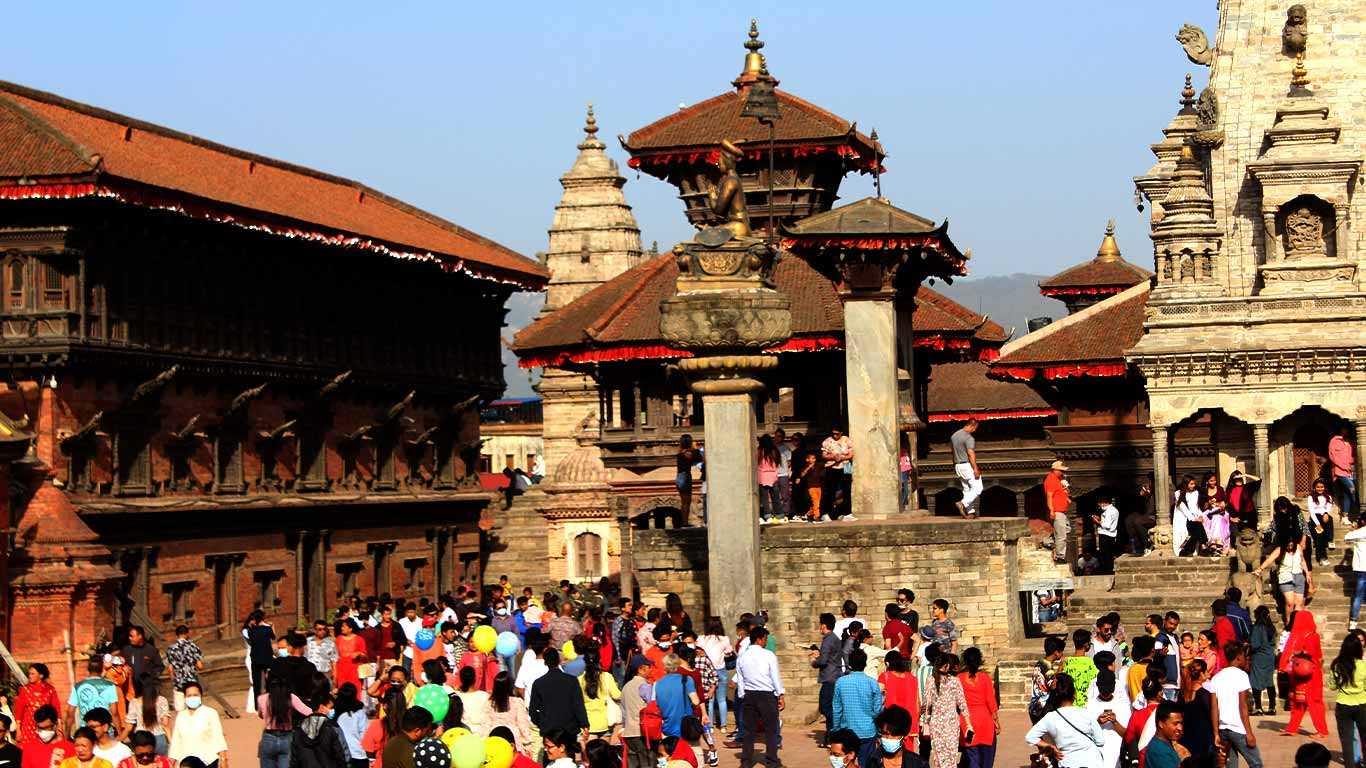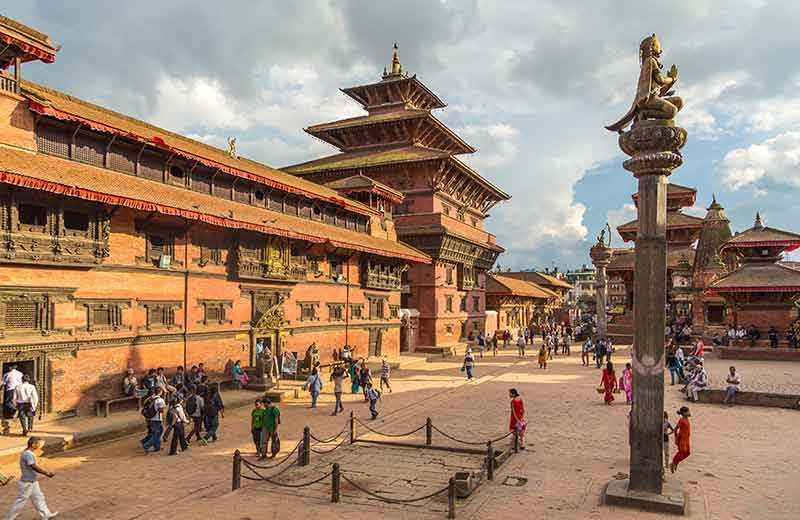List of Unesco World Heritage Sites of Nepal

Locals are participating in their festival in Bhaktapur
Kumari Ghar –
It is the residence of the Living Goddess Kumari, Shiva-Parvati Temple, big bell, Taleju Temple, Jagannath Temple, Krishna Temple, Degutalle Temple, Gaddi Baithak, and Kal Bhairab Temple. These monuments showcase the skill and beauty of Newar handicraft with stone sculptures, bronze art, outstanding woodcarving, pagodas, and built in shikhara style.

The earthquakes in 2015 wreaked havoc on the cultural complex and nearly half of the premises fell, but it has kept its original splendor. The most popular annual fairs and festivals in the Newar Community, such as Indra Jatra, Kumari Jatra, Durga Puja, Ghode Jatra, Yomari Punhi, Machindranath Jatra, and Gaijatra, are celebrated at this durbar square complex and temples.
Tip: Try some authentic Newari food found near the Kasthamandap. Chataamari (Newari-style pizza with different ingredients), Anda Keema (minced meat with egg & soup), Aalo Paratha, Sekuwa & Momos are the must-try foods here.
Patan Durbar Square
As well as being listed as a World Heritage Site in 1979, Patan Durbar Square is located in Patan/Lalitpur (city of beauty), which is 8 km southeast of Kathmandu city. According to legend, the Kirat dynasty founded Patan in the third century.

It was later perfected by the Lichhavis in the sixth century, followed by the Malla dynasty. And parts of this Durbar Square were created by Emperor Ashoka in the 3rd century BCE, according to historical records.
Patan Durbar Square is home to ornately carved shrines, historic royal houses, Buddhist monasteries, Bahals, statues, and temples that are fantastic examples of the distinct Newari culture and architecture.
People's artisans in Thangkas, as well as metal crafts, have flourished in their art. On the durbar grounds, we can also witness magnificent stone and wooden crafts. The exquisite Krishna temple on the west side of Patan Durbar Square is one of a kind, displaying antique stonework.
There are roughly 136 courtyards in the square, with the palace's three principal courtyards, Mul Chowk being the largest and oldest, located in the center. The western half of the complex is made up of several different-sized and styled temples. The Patan Museum, located in Keshav Narayan Chowk, houses some of the finest collections of Newari arts and antiques, including pictures, statues, wood carvings, and paintings.
Within the vicinity, there are 55 prominent temples, such as the Mahaboudha Temple, Krishna Temple, Bhimsen Temple, the Golden Temple, Kumbeshwor Temple, Jagat Narayan Temple, Hari Shanker Temple, Vishwanath Temple, and Rato Machindranath Temple are among the noteworthy attractions to visit in Patan Durbar Square.
Tip: The central Zoo of Nepal is just 30 minutes southwest of this durbar square at Jawalakhel.
Bhaktapur Durbar Square
The Bhaktapur Durbar Square is the last of Kathmandu's three royal palaces, located in Bhaktapur, which is also the medieval kingdom of Kathmandu Valley, along with Kathmandu and Lalitpur cities. Bhaktapur, a literal translation of ‘City of Devotees’, often spelled Khwopa or Bhadgaon, is a historic city about 12 kilometers east of Kathmandu.
Bhaktapur is known as the cradle of Nepali culture, customs, and enticing arts and crafts of exceptional craftsmanship. And Bhaktapur Durbar Square is one of the outstanding examples of Nepali architecture and craftsmanship in Kathmandu. This square is made up of four squares: Durbar Square, Taumadhi Square, Dattatreya Square, and Pottery Square.

Each monument in Bhaktapur is a representation of Nepal's medieval culture, religion, and customs. The 55-window palace, the palace of Malla King Bhupatindra Malla, which took over 50 years to create, stands in the heart of the square, attracting all visitors' attention.
This palace was built in the 18th century and has 55 windows, richly carved interiors, and mural paintings on the inside walls, offering views of the Golden Gate, Taleju Chowk, and Naga Pokhari.
Nyatapola, a five-story pagoda-style temple dedicated to Goddess Siddhalaxmi, is another eye-catching landmark in the square. Dattatraya Square, Taumadhi Square, and the famed Pottery Square, where Newari craftsmen continue to create unique clay designs, are among the other attractions here. You will also find every minor utility that resembles a temple, as well as habitation locations, gossip centers, traditional music, and water springs with a large number of antique enthusiasts.
Tip: Try Ju Ju Dhau (king of yogurt) that comes in a clay pot/cup. It is the most famous thing here, and you won’t be disappointed.
Lumbini – Birthplace of Lord Gautama Buddha
Lumbini is the most sacred pilgrimage site in the world for Buddhist followers, as Lord Buddha was born here around 500 BC and spent his 29 years of life as Prince Siddhartha Gautama.

Lumbini is located southwest of Kathmandu in the southern Terai lowland. Listed as a world heritage site in 1997, the site was located in 1896 by British and European archaeologists after centuries of being lost.
Useful Information about the things to do in Lumbini
Lumbini is home to all of the significant places and monuments associated with Buddha's life. Mayadevi Temple (where Buddha was born), Puskarni Pond (where Buddha's mother bathed before giving birth to Buddha), and Ashoka Pillar (erected by Emperor Ashoka to honor Buddha's birthplace) are among the most noteworthy. Crane Sanctuary, Lumbini Garden, Buddhist Library, Lumbini International Research Institute, World Peace Stupa, and international monasteries are among the other tourist attractions.
Lumbini is now a world peace center, with visitors traveling from all over the world to seek peace, spirituality, and learn about Buddha's philosophy. Meditation classes, workshops, and retreats are available at several monasteries in Lumbini.
Natural Heritage Sites in Nepal
Chitwan National Park
Chitwan National Park (CNP) was established in 1973 and designated as a UNESCO World Heritage Site in 1984. It is the first national park in the country with a 932 sq. km area that stretches over Chitwan, Nawalparasi, Parsa, and Makwanpur districts.
Chitwan National Park is made up of forests, marshland, and grassland, all of which are home to large animal populations, making it one of Asia's top national parks for wildlife viewing, which was once a royal hunting reserve. It is home to over 700 types of fauna, ranging from mammals and reptiles to uncommon bird species.

The endangered Royal Bengal Tiger and the Asian one-horned rhinoceros are the most notable wild animals in this national park. The other well-known species of this sanctuary are Clouded leopards, Sloth Bears, Striped Hyenas, Golden Jackals, Gaurs, Antelopes, Oriental Darters, Kingfishers, Spotted Eagles, King Cobra, Rock Python, Gharials, and Crocodiles. With more than 500 bird species, including the endangered Bengal florican and a great pied hornbill, CNP is also recognized as a bird paradise.
Just beyond the park, the indigenous Tharu people, with their own distinct culture and indigenous wisdom, reside in their traditional houses made of mud and clay. A Tharu Cultural show helps to learn about native tribal life. Interested individuals can engage in a local homestay and experience a distinct way of life in Nepal.
Visiting Royal Chitwan National Park may be a delight for wildlife enthusiasts. The national park is not limited to safaris but also offers more than a dozen activities to entertain the visitors while being inside the sanctuary. Elephant safaris, canoe rides, nature walks, and bird watching are just a few nature-based activities available here.
Take a look at Activities To Do In Chitwan National Park for more!
Sagarmatha National Park
Sagarmatha National Park was established in 1976, and it was declared a world heritage site after 3 years of establishment in 1979. Sagarmatha is the Nepali name of Mount Everest (8848.86m), and the national park is located on the flanks of Mount Everest.
Sagarmatha National Park was the first Himalayan national park to be declared a UNESCO World Heritage Site. Mt. Everest and other peaks above 6000 m high Himalayan peaks as Cho Oyu, Ama Dablam, Thamserku, Lhotse, Pumori, Nuptse, and others, are all included in the national park, as are glaciers and lakes such as Khumbu Glacier and Gokyo Lake, deep valleys inhabited by Sherpas.

The elevation here varies between 2000 and 8848.86 meters. Along with the Himalayas and glacial lakes, the national park is a veritable treasure trove of Himalayan herbs, flowers, and wildlife. The park is home to a diverse range of animals, including over 118 different bird species. The forest is dominated by silver fir, birch, rhododendron, and juniper trees, although trekkers in this area may see musk deer, Himalayan tahr, ghoral, serow, wolf, and Himalayan black bear.
You Might be Interested in the Everest ( Sagarmatha) Base Camp Trek
Snow leopards, red pandas, and two types of magnificent pheasants—the crimson-horned and the Impeyan, Nepal's national bird—are among the endangered species rarely seen. Smaller species such as marmots, pikas, and martens can also be found in the park.
The Sherpa people, with their unique Buddhist culture and mountain lives, as well as their outstanding ability to climb mountains, and the highest monastery of Nepal, Tengboche Monastery (3600m), are well-known in the Sagarmatha region. Over the top, the Everest Base Camp, located in Sagarmatha National Park, is the world's most famous trekking destination, and trekkers visit Sagarmatha National Park only for this reason.
These 10 listed World Heritage Sites showcase a glimpse of the cultural and natural treasures of Nepal. So, take a trip to Nepal to see some of these incredible sites and learn how its flawless geography is brimming with singular, fantastic energy that is suitable for high-level spiritual well-being experiences.
Read more blogs
